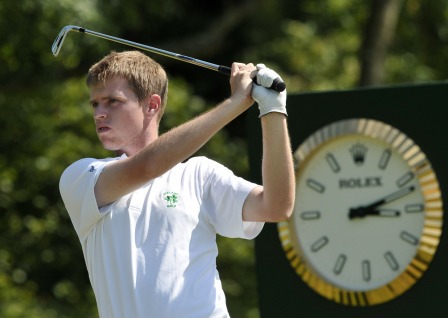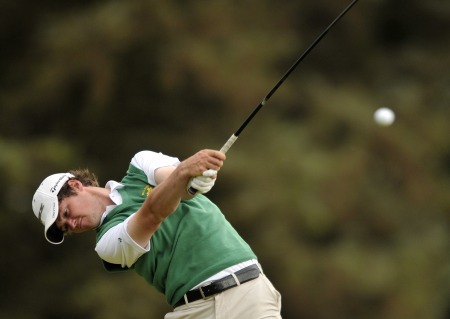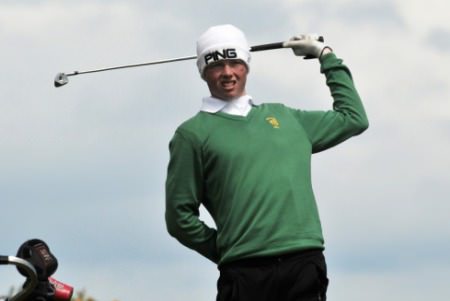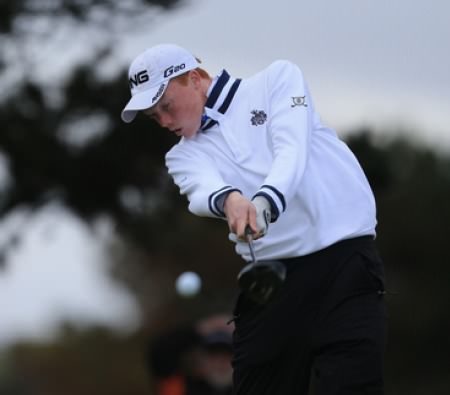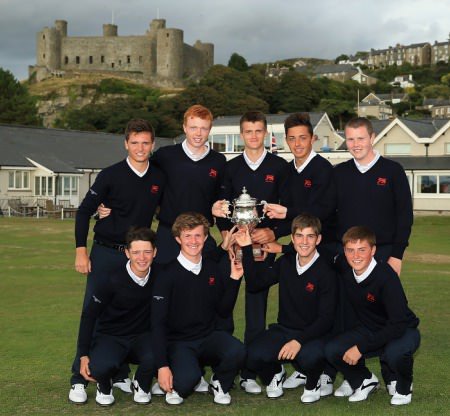Ballybunion Old to host Jacques Leglise in 2017

Ballybunion Golf Cub's Old Course. Picture via ballybuniongolfclub.ie
Ballybunion’s Old Course will host the Jacques Leglise Trophy for the first time from 1-2 September 2017.
The County Kerry links, which hosted the Irish Open in 2000 and the Palmer Cup in 2004 as well as the Home International Matches in 2003 and the Irish Seniors Open on the European Senior Tour in 2009.
The R&A announced its venues for the 2017 Championships and International Matches today with Royal St George’s, where Darren Clarke won The Open in 2011, set to host the Amateur Championship for the 14th time with the qualifying stroke play rounds being played at nearby Prince’s.
It's the first staging of the Amateur Championship at Sandwich since 2006 when Frenchman Julien Guerrier defeated Adam Gee from Leatherhead by 4&3 in the 36-hole final. Among the winners of the championship at Royal St George’s are the great amateurs John Ball Junior, Freddie Tait and Harold Hilton.
Open Champion Rory McIlroy is one of several Champions and Ryder Cup team members who have played in the Amateur Championship over the years including Jack Nicklaus, Sir Nick Faldo, Darren Clarke, Padraig Harrington, Henrik Stenson, Louis Oosthuizen, Ernie Els, Colin Montgomerie and Jose Maria Olazabal, who won in 1984, and Sergio Garcia, who won in 1998.
The Boys Amateur Championship will be played at The Nairn Golf Club and nearby Nairn Dunbar Golf Club. It will be the second time the championship has been played at Nairn and the first occasion since 1989 when Carl Watts from Dyke lifted the trophy.
Ballybunion Golf Cub's Old Course. Picture via ballybuniongolfclub.ie
A field of 252 of the world’s leading boy golfers will take part in the championship which featured 23 nationalities in the 2014 event. Previous winners include Sergio Garcia, Jose Maria Olazabal and Sir Michael Bonallack while Major Championship winners Sandy Lyle, Padraig Harrington, Graeme McDowell, Martin Kaymer and Rory McIlroy have all played in the event.
Johnnie Cole-Hamilton, Executive Director – Championships at The R&A, said, “We are looking forward to staging the 2017 championships at some of the most renowned courses in Great Britain and Ireland.
"The venues each have illustrious histories and will provide wonderful tests of golf. I’m sure the players will enjoy the challenge they present and that spectators will take the opportunity to come and watch some top class amateur golf.”
The Boys Home Internationals will be played at St Annes Old Links, which was a Local Final Qualifying venue for The Open at Royal Lytham & St Annes in 2012.
The 46th Walker Cup match between Great Britain and Ireland and the USA will be played at Los Angeles Country Club in California.
According to Ballybunion's website:
"In early 1897 an article in the Irish Times, headed The Golf Links of Kerry, dismissed Ballybunion Course with some contempt as “a rabbit warren below the village, where a golfer requires limitless patience and an inexhaustible supply of golf balls.” This provoked a tart rejoinder in the same paper in March 1897 from P McCarthy, General Manager, Listowel and Ballybunion Railway. The course, he claimed, was “quite first class and a sporting course, laid out by the professional who had laid out the links at Lahinch and Dollymount.” The Irish golfers guide of 1897 names this course designer as James McKenna, who did this work “at the instance of the Lartigue Railway Company.” It is interesting to note the connection with present day Ballybunion as he was the grandfather of the Ballybunion Golf Club Secretary – Manager until 2008, Jim McKenna.
"But despite the best endeavours of these early enthusiasts the Club was not financially equipped to survive, and lapsed in 1898. There then followed an 8 year period of golfing oblivion which lasted right up until the formation of the present Ballybunion Golf Club in 1906. Its founders were Colonel Bartholomew, an ex-Indian Army Officer who had retired to live in the area, Mr B.J. Johnstone of the Bank of Ireland, Patrick McCarthy, Honorary Secretary of the original Club, and John Macauley of Listowel. Under their auspices, Mr Lionel Hewson, for many years the Editor of Irish Golf and one of the great personalities of the game, was commissioned to lay out a new 9 hole track.
"As time passed, the growing reputation of the links began to attracted players from all parts of the country, and by 1926 plans had been drawn up to extend the course to a full 18 holes. Work was completed within the following 12 months, but it wasn’t until 1932 that the new links were finally recognized at national level when Ballybunion was chosen as the venue for the Irish Ladies Championship. This was won by a club member from Tralee, Miss Betty Latchford. A repeat of this championship in 1936 was won by Mrs Clarrie Reddaw. Four subsequent runnings of this championship went to Miss Philomena Garvey [1951], Miss Mary McKenna [1969 and 1977] and Miss Claire Hourihane [1991]. The GUI. has run its Irish Amateur Close Championship here on five occasions. The champions of these years were Jimmy Bruen [1937], Cecil Ewing [1958], Ray Kane [1971], Jackie Harrington [1979] and Gary McNeil [1991].
"Five years later it became the stage for the Irish Mens Close Amateur Championship. As part of the preparation for this prestigious event, the Committee appointed Tom Simpson, a leading golf architect of the time, to examine the course and make any necessary recommendations. Simpson was so delighted by what he saw that he suggested only three major changes – altering the sites of the 7th and 13th holes – and some minor ones, which included the installation of a mid-fairway bunker on what is now the 1st hole. This bunker became known as “Mrs Simpson”, and though opinions about it may differ widely, it at least has the merit of providing the topic for much animated discussion!
"The next significant date in Ballybunion’s history was 1957 when the course was selected as the venue for the Irish Professional Championship. Harry Bradshaw emerged victorious in what was to be the last of his 10 national titles. Further attention from the mass media came in 1970 with the arrival of television cameras to record the match between Ireland’s Christy O’Connor and Bob Goalby from the United States for the World of Golf TV series. In 1967 The Irish Professional Championship returned to Ballybunion won by Jimmy Kinsella; in 1978 Arnold O’Connor won the Carroll’s Irish Matchplay Championship here. 1971 triggered the start of a new era for Ballybunion Golf Club. Land was purchased on which the Cashen Course was to be built. The Club left its clubhouse on the present sixth tee and built a new clubhouse, on the present site of the clubhouse, central to both courses. We took a sudden leap into intemational prominence when world-acclaimed golf writer, Herbert Warren Wind, wrote an article ranking Ballybunion in the world’s Top Ten Courses.
"Things were never quite the same again. Hordes of visitors, very many from the U.S.A., thronged to Ballybunion. Among these was Ballybunion’s favourite adopted son Tom Watson, who came first with his friend Sandy Satum in 1981, and has been a regular since. He has brought with him legendary figures of golf, Byron Nelson and Lee Trevino, Jack Nicklaus, Nick Faldo, Cohn Montgomery, Larry Mize, Steve Jones, Wayne Grady, Ian Woosnam, Bob Murphy, Jerry Pate, Peter Thompson, Peter Alliss, Deane Beman, Ken Venturi, Ben Wright also visited. From the U.S. Ladies Tour we have welcomed Pat Bradley, Val Skinner and Cindy Rarick. The club called on the doyen of Golf Architects, Robert Trent Jones, to design the Cashen course on its newly-acquired property. This course is increasingly finding favour on all fronts despite vying for attention with the agelessly-beautiful old course.
"In 1993 Ballybunion Golf Club celebrated that proudest of milestones – its centenary. Fittingly its centenary captain was Sean Walsh, who as Sec/Manager since 1972, had overseen and contributed enormously to the fantastic development of the club in that time. Centenary celebrations befitting the status of the club were organised. Nothing was more adventurous than the decision to raze the 1971 clubhouse and to build the present new clubhouse to usher Ballybunion Golf Club into the 21st century. In 1995 Tom Watson undertook what was for him a labour of love, updating the old course, giving a facelift to the century-old lady so beloved by all. After his deft and loving surgery she now presents to the world a face more beautiful than ever."
The great American writer Herbert Warren Wind visited Ballybunion in 1971 and penned this memorable essay:
Ballybunion
There is a land that compares with Scotland in the quality of its best courses, it is Ireland. Some years ago I circled the island to play its most celebrated links: Portmarnock, Royal County Down, Royal Portrush, Rosses Point in Sligo, Lahinch, and Ballybunion. Portmarnock and Royal County Down deserve consideration in any golfer’s list of the dozen finest courses in the world, but it is Ballybunion that really bowls over the visiting golfer. I went to Ballybunion from Killarney with a small party headed up by Dr. Billy O’Sullivan and was awed by the course. It is something like a Gaelic version of Pebble Beach.
I should make three points to bring matters up to date. First, about a decade ago, a new clubhouse was built next to the thirteenth, and that hole now is the opening hole. The old eighteenth is now the fifth, the old first is now the sixth, and so on. It makes for a much better routing. Second, the old green on the old second was lost because of erosion, but the new green, nicely situated behind the large sand hill, makes it a very good hole if not quite the test it was when the old green stood at the edge of the cliffs. And third, Ballybunion now has a fine second eighteen-hole course laid out by Robert Trent Jones in the sturdy duneland contiguous to the first eighteen.
My schedule for Sunday called for me to drive to Ballybunion, an hour and a half away, and return to Killarney in the evening.
Ballybunion was the last course on the itinerary that MacWeeney had prepared for me, and, in a way, 1 was glad that it was. T had been moving at a pretty fast clip, and the succession of long days and late nights was beginning to get to me. Accordingly, I planned to take it easy on Sunday: I would sleep until ten, wrap up Ballybunion as quickly as possible, and get to bed back in Killarney no later than ten that evening.
The day worked out very well, but somewhat differently from what I had planned. At eight o'clock, I was awakened by a telephone call from Dr. O'Sullivan. Wouldn't it be pleasanter for me if I had some company on my trip to Ballybunion? Indeed it would, I told him. Very well, then—he and Finbarr Slattery would come by my hotel and collect me at nine-thirty. I had no sooner hung up, it seemed, than the phone rang again. It was Slattery, announcing that he was looking forward eagerly to the day's excursion.
Ballybunion is a small gray seaside resort in northern Kerry, fifty miles west of Limerick and twenty miles due north of Tralee. A far less prepossessing village than Lahinch, it stands on the south shore of the Shannon estuary, facing the Atlantic. Though it was thick with holiday people this Sunday, I gathered from Dr. O'Sullivan that it had never been very prosperous. The golf links, he said, had suffered down through the years from lack of funds. In his opinion, the course was potentially the equal of any in Ireland, but the club had never had the wherewithal to maintain it in first-class condition or to develop it as a richer club might have. On top of this, there was now the problem of erosion to cope with. Some sections of the high, steep cliffs along the shore were slipping into the ocean, and not at a geological rate, either; in fact, one or two greens might be lost in a matter of years. The principal point he wished to stress, however, was the quality of the course. One Irish Professional Championship, two Irish Amateurs, and two Irish Ladies' Championships had been held there, and he had yet to meet the golfer who had not been both charmed and awed by Ballybunion. "On the other hand, it's virtually unknown," he added. "Very few tourists from Britain or America—or, for that matter, from other parts of Ireland—bother to visit it. They know about Ballybunion, lull it's stuck oil by itself on the mail to nowhere, so in the end they pass it by. They make a tremendous mistake."
At first glance, even the most distinguished linksland courses look utterly ordinary to the man who has never played them before. If a golfer stands on the terrace at the Augusta National Golf Club, say, and takes in the wide panorama of lush fairways swinging through tall pines, he senses at once that an authentic championship layout awaits him—an experience that also occurs at most of the world's renowned inland courses. But let him stand on the first tee at St. Andrews or Ballybunion, and all he sees is a treeless sweep of billowing pale-green land with a few dun-colored sand hills in the distance—a most unpromising vista.
A fragment of fairway is visible here and another fragment there, and a few numbered flags are blowing in the breeze, so what he is looking at is evidently a golf course, but it might as easily be pastureland. It is only when the golfer gets out onto a linksland course that he discovers, to his amazement, that it is filled with great golf holes, all the more appealing since their strategic features were molded by nature instead of by the bulldozer. I should state before going any farther that I did not play Ballybunion. In retrospect, I regret this, but when we arrived that morning a chilly, moisture-laden twenty-knot wind was busting in off the ocean, and it completely doused what little desire I had to play golf. I could picture myself having one of my sparkling rounds, in which I would be standing deep in the alien corn on shot after shot while Dr. O'Sullivan patiently studied some adjacent par-3 hole and Slattery ruminated over the stubborn refusal of the local farmers to give up their traditional potatoes and raise dairy cattle instead, as he had been urging them to. Instead, we walked the eighteen holes. At the start, there were just the three of us up from Killarney, but on the second hole we were joined by Paddy Allen, a dedicated Ballybunion man in his sixties, who had long been one of the club's best players and was now a club trustee. Allen had been waiting at the small, plain clubhouse to greet us on our arrival, along with his brother Tom, the club steward upward of fifty years, and both had been openly delighted at seeing Dr. O’Sullivan. Allen had then phoned the captain and a few other members about our plans for the day before catching up with us. By the time we reached the fifth tee, our walking party had been supplemented by a dozen Ballybunion men, among them the captain, J. D. Mahony; the secretary, Michael Handrahan; and a Dr. Walsh, who was forced to leave us at the fifteenth hole when a young boy raced out to inform him he was urgently needed to deliver a baby. In its general pattern, this walk was similar to the shorter one I had made with Mixie Murphy's band at County Sligo; groups of two or three went off by themselves and then converged at some natural collecting point, like a bunker, where new clusters broke off. Despite the ripping wind and some intermittent rain, the walk, which took two hours, was profoundly exciting.
To put it simply, Ballybunion revealed itself to be nothing less than the finest seaside course I have ever seen. It shows its quality on the very first hole, a par 4 that doglegs to the left and seems a good bit longer than 372 yards—its length on the scorecard. From the tee, the hole appears to be a rather banal par 4, but when, upon reaching that point in the fairway where an adequate drive would finish, you study the long, narrow green, a medium-iron away, and the fanciful convolutions of the land in the green area, your assessment changes radically. It is, you perceive, a formidable, arresting hole. When I expressed these thoughts to Dr. O'Sullivan, he agreed completely. He went on to observe that he had never seen Ballybunion in such excellent condition. "Usually, it's all kind of shaggy and spotty, but everything's cut so crisp today. Maybe it's because they knew we were coming. Whatever the reason, the course looks grand, doesn't it?"
The second hole certainly did. It is a 413-yard par 4 running roughly parallel to the seventy-foot-high cliffs that plunge down to the beach and the water. Actually, the hole plays as a slight dogleg, to the right. The correct line on the tee shot is down the left side of the fairway, for this opens up the entrance to the green, which is flanked on the left by a massive sand hill and on the right by the cliffs. From the tee, the entire hole is visible, and, as if this were not an exhilarating enough prospect, farther in the distance, at the end of a tight valley between two rows of sandhills, the eye takes in the minute green of another dazzling cliffside hole, the sixth. I breathed it all in slowly, wondering first to myself and then aloud who the architect was who had had the genius to use the duneland in such a thrilling way.
Dr. O’Sullivan didn't know, but when I later asked Paddy Allen he told me that the credit for both holes belonged to the late Tom Simpson, a much admired English architect; they were two of four holes that Simpson had substantially improved when he remodelled the course in the nineteen-thirties. Allen said this with a dour matter-of-factness that didn't tally with the pleasure a dedicated Ballybunion man would normally take in showing these superior holes to visitors. His voice and his countenance became noticeably grimmer a moment later, when, after we had walked behind the second green, he pointed out some rude wooden props that had been rigged against the face of the cliff.
This was one of the places where erosion was proceeding at alarming speed. He shook his head sadly as we walked back to a sheltered basin on the inland side of the large sand hill flanking the green. "If we lose the second green," he said, "this is where the new green will probably go."
"It will ruin the hole, Paddy," Dr. O'Sullivan expostulated.
Allen opened his palms in a gesture of resignation. "Yes, Billy," he said. "It will be just another golf hole." He walked away to commune with himself.
A tourist driving through Switzerland is staggered by its prodigal beauty; around the bend from the most wondrous view he has ever beheld he comes upon a view that surpasses it—and so on and on, endlessly. Ballybunion is something like that. I do not mean to suggest that there are vistas that put the one from the second tee to shame—there aren't—but there is a correspondence in the way one stirring hole is followed by another and another. The third, for example, is a 145-yarder that moves through the sand hills to a devilish little green that tips into an abrupt downslope on the right and is bunkered on the left and in front. On the fourth, a 451-yard par 4 on the inland side of the sand-hill belt, the key hazard is a deep bunker carved in the face of a rise in the middle of the fairway about twenty yards in front of the plateau green; anything less than a perfectly struck second shot will end up in it. (A sign at the edge of the hunker informs the golfer that it is called the Crow's Nest. There are similar signs at the other major hazards on the course—an original touch and a flavorsome one.) The fifth hole, which curves back toward the ocean through another twisting valley, is a very attractive drive-and-pitch par 4, 343 yards long, a dogleg to the left this time. The sixth, which I've already mentioned, is a perfect beauty—a 450-yard par 4 that tumbles downhill along the cliffs to an inviting green. And that is the way it keeps going at Ballybunion. There is not one prosaic hole—not one single "breather"—in the whole eighteen. If the course has a weakness, I suppose it is the comparative plainness of the last two holes—a pair of par 5s stretching over the somewhat featureless interior ground. They are not trite holes, for they are imaginatively bunkered, but they do lack the beauty of the rest of the course, and as a result they are somewhat anticlimactic.
Herbert Warren Wind
At the conclusion of our walk, I found I could remember each of the eighteen holes without much trouble. This is probably the oldest and soundest rule of thumb for judging the merits of a course that a golfer has just seen for the first time. Apart from the first six holes, three others remained especially distinct: the tenth, a 210-yarder over difficult duneland, where the prevailing wind, from the west, sweeps across from left to right; the 368-yard thirteenth, where the sand in a fifty-yard-wide bunker called the Sahara is strewn with deer bones, shells, stones, and ashes deposited in the fifteenth century by a tribe that used the cavity as a midden, or dump; and the fourteenth, a 376-yard par 4 that Simpson enlivened by placing in the drive zone a mounded double bunker, which the members immediately dubbed Mrs. Simpson.
Ballybunion is a moderate 6,317 yards in length, par is 71 (34-37), the course record is 65, and, as I say, no other links, in my opinion, presents such a satisfying adventure in golf. The course has two endowments that I believe to be unique. First, it is the only links I know of where most of the oceanside holes are perched atop spectacular cliffs, in the manner of Pebble Beach (which is not a true links). Second—and this is undoubtedly the secret of its character and charm—it is the only links I know of where the sand-hill ridges do not run parallel to the shoreline but at a decided traverse. This opens all sorts of possibilities—dogleg holes of every description sculptured through the choppy land, and straightaway holes where the sand hills patrol the entrance to the green like the Pillars of Hercules. One more point: Unlike most links, Ballybunion challenges you with target golf. There is none of that bouncing your iron approach short of the green and letting it bobble toward the flag, as you do on most courses in the British Isles. No, you aim for the flag, and if your shot lands on the green the green is sufficiently receptive to hold it.
The miracle is that every one of the several golf architects who had a hand in creating Ballybunion recognized how the terrain should be handled. During lunch, at the Castle Hotel, Paddy Allen, having pored over the club records at the finish of our walk, supplied some information on these architects. The man who took care of the course when Ballybunion was founded, in 1896, was one P. Murphy, who was paid nine shillings a week, financial woes brought the original organization down, and the Club was re-formed in 1906, at which time Captain Lionel Hewson, for many years the editor of the magazine Irish Golf, built the nine holes that became the basis of the present layout. In 1926, when the course was extended to eighteen holes, the work was directed by a man named Smyth, who was a designer on the staff of Carter & Sons, a London firm specializing in the Construction of sports grounds. Then, in 1936, Simpson was brought in to remodel the course. He was given carte blanche, but, recognizing the unusual worth of the existing layout— something that few architects would have managed to do, in their eagerness to edit their predecessors—he made only four changes: he re-sited the second, fourth, and eighth greens and introduced the Mrs. Simpson double bunker on the fourteenth. Finally, the course reflects the devotion of William J. McCarthy, a local solicitor and hotel owner, whose father was one of the club's founders.
McCarthy, who is still active in the club, served for more than two decades as Ballybunion's honorary secretary and also performed the duties of a kind of resident architect. In the early nineteen-fifties, he built two first-class new holes to replace the old eleventh and twelfth, but, in truth, there is hardly a hole that McCarthy has not enhanced by some skillful little touch, like recontouring a bunker or relocating a tee.
During lunch, Dr. O'Sullivan, both as a regional hero and as the representative of a more thriving and worldly golf club, was kept busy answering a stream of questions from the Ballybunion men about how they might go about improving their hard-pressed operation. The Doctor strongly recommended that the members, if they were in a position to do so, acquire the seashore property adjacent to the course, as a safeguard against invasion by get-rich-quick realtors. He emphatically supported the proposal that a new clubhouse, however modest, be built as soon as possible at the edge of the sea, close by either the sixth or the tenth green. (One of the incidental advantages of such a move would be that the order of the holes would necessarily be changed for the better if either the seventh or eleventh became the first hole, for then the present seventeenth and eighteenth would be played in the middle of a round, and the course would surge to a much more stirring finish.) He also suggested that the club seek professional guidance in dealing with the erosion problem. He was listened to most attentively. In fact, there were only a few light moments during the lunch. One of them came when Dr. Walsh, the delivery completed, rejoined the party. Was it a boy, he was asked. "No," he said. "Only a child."
My overriding memory of the lunch, however, is the unbroken gravity of the Ballybunion men as they discussed with Dr. O'Sullivan the steps they should take to make the golf world more conscious of their course. Paddy Allen was still wrestling with that problem when I said goodbye to him. "We can't expect anything like the number of tourists Portmarnock gets," he told me, in a small voice that grew emotional despite his efforts to speak calmly. "But we need a better bite off the plum—a much better bite. As you saw for yourself, Ballybunion is a fine, fine course. And that champagne air off the ocean—" He broke off, then continued, "The course means everything here. Take away the golf course and you take away Ballybunion."
Championships and International Matches in 2017
- The Amateur Championship at Royal St George’s and Prince’s: 19-24 June
- The Boys Home Internationals, St Annes Old Links: 8-10 August
- The Seniors Amateur Championship, Sunningdale (Old Course): 9-11 August
- The Boys Amateur Championship, The Nairn and Nairn Dunbar: 15-20 August
- The Jacques Leglise Trophy, Ballybunion (Old Course): 1 and 2 September
- The Walker Cup, Los Angeles Country Club: 9 and 10 September





